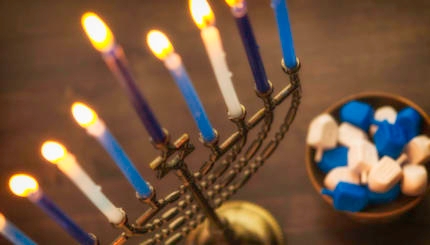The rhythm of Jewish time is determined both by the sun and by the moon. The basic unit of time is naturally enough the day, which is a unit of time determined by the amount of sunlight reaching the earth as it rotates on its axis. In the Western world a day begins in the middle of the night and lasts until the next midnight. Since the standardization of time, days are divided into regular segments of 24 hours.
Looking for a Jewish calendar? Click here to create a free, customized, printable Jewish calendar. You can also download free digital Jewish calendar apps for your mobile device at Apple’s App Store or Google Play. Or purchase a printed calendar here.
The Jewish day is also ruled by the sun. However, it is more firmly rooted in simply observable phenomena than our standard day. If we didn’t have clocks and watches, we would never be able to determine at what moment one day ends and the next one begins. Following Genesis 1, in which the refrain “it was evening and it was morning” sums up each day’s creative work, Judaism measures its day from one evening to the next. Of course, the question arises how to define the exact moment when one day ends and the next begins.
Why the Jewish Day Begins in the Evening
The rabbis determined that the new day begins at the moment when the sun sinks below the horizon. Unlike our secular day, in which the daylight hours are framed by night, the Jewish day begins with night and ends with day.

Help us keep Jewish knowledge accessible to millions of people around the world.
Your donation to My Jewish Learning fuels endless journeys of Jewish discovery. With your help, My Jewish Learning can continue to provide nonstop opportunities for learning, connection and growth.
This is the reason why all Jewish holidays begin in the evening before the first day of the observance. In fact, according to a Jewish reckoning of time, the evening before the day is indeed the beginning of the new calendar day.
The Story of Creation
The first story of creation in Genesis 1:1-2:4 also establishes the next higher unit of measuring time, namely the seven-day week. This tale serves to place the week firmly within the divine plan, in which a six-day workweek is followed by the sacred Sabbath, a divinely ordained day of rest. Since most units of measurement ultimately go back to the Babylonians, who were the first great astronomers and natural observers of the ancient world, we know that the week is meant to be coordinated with the four phases of the moon.
Therefore, roughly speaking, four weeks make a month. And roughly 12 months make a year. Since, however, the 12-month lunar year and the 365-day solar calendar do not overlap exactly, the Gregorian calendar that has become the standard world calendar has months of unequal length that no longer correlate with the phases of the moon and has to insert an extra day every four years (the leap year) in order to have the calendar reflect the solar year.
Leap Years and Other Adjustments
This becomes somewhat more complicated in the case of the Jewish calendar, for it is still coordinated with the phases of the moon. Indeed, it is that which determines the times of the Jewish holidays. This is of particular importance with those that fall on the new moon and those that are celebrated at the time of the full moon. In addition, since the 12-month lunar year is a few days shorter than a solar year, strict adherence to a lunar calendar would mean that the holidays would eventually take place at the wrong season.
This would mean that every now and then we would celebrate Hanukkah, the mid-winter festival of lights, in the middle of summer and Sukkot, the autumn harvest festival, in the early spring. Therefore, in an attempt to coordinate the traditional lunar year with the solar year Judaism has worked out a system of 19-year cycles, in which there are seven leap years. In distinction to the day added to the secular leap year, the Jewish calendar adds a full month to the end of its year. In this manner the Jewish holidays fluctuate by about a month or so in relationship to the Gregorian calendar, but always fall at the same time of year. It is interesting to note that Islam also follows a lunar calendar. In contrast to Judaism, however, the Islamic calendar is strictly a lunar one and is not coordinated with the solar year. Thus, over the course of time, holidays such as Ramadan, occur at different seasons.



